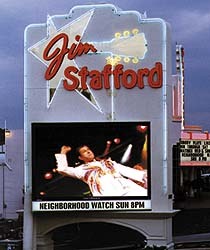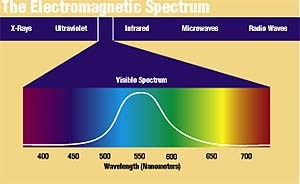Electric Signs
Digital Video Basics
Exploring the operating fundamentals of electronic displays
Published
18 years agoon

Digital imaging has become the foundation of modern signage and graphics production. With the advent of digital video, however, moving pictures became part of the same discipline as static images. To understand the elements affecting quality of moving-message signs, it’s important to know something about how digital video is created. Because this subject is extremely complex, I will focus only on some basic parameters.
What’s digital?
Although it’s a huge buzzword today, not everyone who speaks or writes the word "digital" understands its meaning. "Digital" refers to a numeric (binary) representation of signals captured from the physical world, including sounds and images. Video signals are "digitized" by a two-step process. "Sampling" divides a two-dimensional image plane into small, discrete regions. "Quantization" assigns a numeric value that corresponds to the specific amplitude of the image signal in each of these component regions. To create digital motion pictures, the image signal must be sampled in the dimension of time, as well as in the horizontal and vertical dimensions of the image plane or "frame."
Both digital video and conventional image processing employ standard, rectangular grids to represent sampled images. Thus, any digital image is represented by a matrix of numeric values. In turn, the value assigned to each component (or "pixel") in the matrix represents a sampling of information that surrounds a corresponding point in the image. Each pixel includes information for all color components (i.e., red, green and blue in a full-color, RGB display). In digital printing, pixels are ink dots, but in video displays, they consist of electrical or electronic components (i.e., light bulbs, LEDs, LCDs or plasma cells). Fig. 2 shows some typical pixel arrays for various types of video displays.
Resolution
Picture quality is the bottom line for comparing video systems. Simply defined, "resolution" is an imaging system’s capability to reproduce fine detail in the image. Just as the quality of a digital color print depends on the number of dots per inch (dpi), the absolute limit of a video display’s resolution corresponds to the number of pixels encompassed within the matrix’s width and height.
For example, the 9 x 14-ft., full-color LED display furnished by Daktronics Inc. (Brookings, SD) for Jim Stafford Theatre in Branson, MO (Fig. 1), comprises a 112 x 176 matrix (approximately 20 kilopixels). According to Fig. 2, this electronic sign is categorized as a low-resolution video display. Because its matrix size is typical of outdoor, full-color LED displays, however, what explains this sign’s excellent picture quality?Daktronics Inc.
The answer involves viewing distance. As the viewer gets farther away from a display, it’s more difficult for the human eye to discern variations between individual pixels. In large-format video displays, TV-quality resolution isn’t necessary to achieve a suitable appearance. Similarly, the required dpi registration for digital color prints depends on the print’s size and proposed viewing distance.
Raster images
Because digital video is a subset of digital imaging, the raster-imaging process used to create digital color prints also applies to scanning video images onto display screens. To create a direct representation of the sampled image, the display transmits each pixel’s grayscale or color information to the screen in the form of consecutive, horizontal, parallel scan lines.
Four main types of raster images are defined by the amount of image data they require. A "bilevel" image carries only one "bit" of image data per pixel. This single bit represents either black or white (with no grayscale capability). Although "monochrome" typically refers to bilevel-type computer monitors, this term is expanded in video parlance to describe both bilevel and grayscale displays.
"Pseudocolor" systems (also known as "colormapped") incorporate several bits for each pixel. For example, an 8-bit, pseudocolor system can display up to 256 colors. This type of display is suitable primarily for rendering graphics like maps, diagrams and cartoons.
An 8-bit, "grayscale" display can represent all tones from black to white, including various grays. Thus, a grayscale system can display a full range of black-and-white images.
"Truecolor" systems (also known as "full-color") incorporate separate red, green and blue components for each pixel in the image matrix. Because each color comprises a "byte" (8 bits), each truecolor pixel contains 24 bits of color information. Each pixel in a 24-bit truecolor system can theoretically represent 16.7 million distinct codes or colors. How many of these codes actually represent discernable colors depends on the display’s transfer function (i.e., SMPTE 240M for high-definition TV).
Transfer function involves a process known as "gamma correction" that affects the image’s perceptual quality. In terms of picture quality, this factor is equally important to the accuracy of signal-intensity across the display. When the proper transfer function is matched with a 24-bit color display system, near-photographic quality images are possible. By itself, however, 24 bits of image data per pixel doesn’t guarantee excellent image quality.
Brightness
Color-perception standards are established by the Commission Internationale de L’Eclairage (International Commission on Illumination, CIE). The CIE defines "brightness" as follows: "The attribute of a visual sensation according to which a given area appears to exhibit more or less light." Brightness, therefore, is a subjective quality that involves more than simply the physical intensity of a given light source. The human eye’s ability to perceive various colors is also an important factor (Fig. 3).
In addition to intensity and color of the light source, a display’s degree of contrast is extremely important to picture quality. "Contrast ratio" is the ratio of luminance between an image’s lightest and darkest elements.
Outdoor electronic signs present a unique challenge in this regard. Unlike ordinary electronic displays that are operated in areas with fairly constant ambient light and viewing conditions, outdoor moving-message signs operate in a wide range of illumination levels. Electronic-sign manufacturers address this factor by incorporating various filters, louvers and brightness controls, as well as by the designs of display pixels and modules. Although the art of digital video involves a substantial amount of hard science, human perception factors are equally crucial for display quality.
Screen gems
As the quality of electronic signs improves, the distinctions between large-format message boards and big-screen TVs will be less evident. Examining the ever-expanding product lines offered by electronic-sign manufacturers, it’s a safe bet that video advertising will play an even larger role in the future. This may be the prelude to an era in which electronic displays become an active component of nearly every public environment. Some people are excited because this means the electronic-sign business will continue to thrive. But others are ecstatic that TV deprivation may be cured in our lifetimes.

SPONSORED VIDEO
Introducing the Sign Industry Podcast
The Sign Industry Podcast is a platform for every sign person out there — from the old-timers who bent neon and hand-lettered boats to those venturing into new technologies — we want to get their stories out for everyone to hear. Come join us and listen to stories, learn tricks or techniques, and get insights of what’s to come. We are the world’s second oldest profession. The folks who started the world’s oldest profession needed a sign.
You may like

PRINTING United Alliance Forms Strategic Partnership with ASI

The Joy of Working

5 Signs That Embody Care and Gratitude
Subscribe

Bulletins
Get the most important news and business ideas from Signs of the Times magazine's news bulletin.
Most Popular
-

 Photo Gallery1 week ago
Photo Gallery1 week ago30 Snapshots of the 2024 ISA Sign Expo
-

 Ask Signs of the Times2 weeks ago
Ask Signs of the Times2 weeks agoWhy Are Signs from Canva so Overloaded and Similar?
-

 Paula Fargo6 days ago
Paula Fargo6 days ago5 Reasons to Sell a Sign Company Plus 6 Options
-

 Real Deal3 days ago
Real Deal3 days agoA Woman Sign Company Owner Confronts a Sexist Wholesaler
-

 Benchmarks2 weeks ago
Benchmarks2 weeks ago6 Sports Venue Signs Deserving a Standing Ovation
-

 Photo Gallery6 days ago
Photo Gallery6 days ago21 Larry Albright Plasma Globes, Crackle Tubes and More
-

 Women in Signs2 weeks ago
Women in Signs2 weeks ago2024 Women in Signs: Brandi Pulliam Blanton
-

 Women in Signs1 week ago
Women in Signs1 week ago2024 Women in Signs: Alicia Brothers














